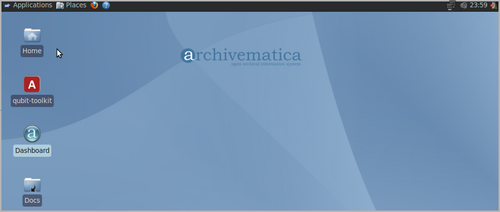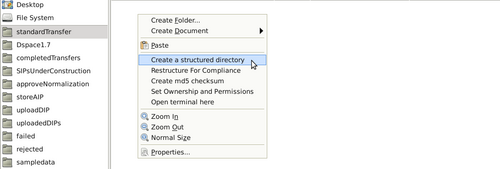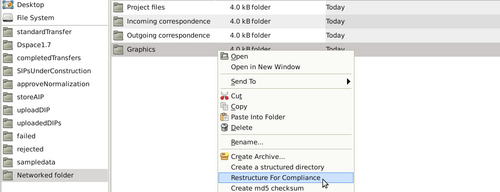Difference between revisions of "UM transfer"
Jump to navigation
Jump to search
| Line 9: | Line 9: | ||
At the end of transfer, the user can select a number of ways to create one or more SIPs from the transfer. Once this is done, the SIP(s) are moved into ingest. | At the end of transfer, the user can select a number of ways to create one or more SIPs from the transfer. Once this is done, the SIP(s) are moved into ingest. | ||
| + | |||
| + | == Create a transfer == | ||
| + | |||
| + | #Open the file browser by clicking on the Home folder on the Archivematica desktop. [[Image:desktopg.png|500px|right|thumb|Click on the Home folder on the Archivematica desktop]] | ||
</div> | </div> | ||
| − | = | + | <div class="clearfix"> |
| − | + | </div> | |
=== Option 1 === | === Option 1 === | ||
| Line 20: | Line 24: | ||
#Right-click and select "Create a structured directory" | #Right-click and select "Create a structured directory" | ||
#The structured directory will contain three subdirectories: logs, metadata, objects. Copy the digital files to be preserved into the /objects directory. Note that you can create subdirectories within /objects if desired.[[Image:structuredDirectoryg.png|500px|right|thumb|Option 1: right-click and create a structured directory]] | #The structured directory will contain three subdirectories: logs, metadata, objects. Copy the digital files to be preserved into the /objects directory. Note that you can create subdirectories within /objects if desired.[[Image:structuredDirectoryg.png|500px|right|thumb|Option 1: right-click and create a structured directory]] | ||
| + | |||
| + | </div> | ||
| + | |||
| + | <div class="clearfix"> | ||
| + | |||
| + | </div> | ||
=== Option 2 === | === Option 2 === | ||
Revision as of 14:33, 23 January 2012
Main Page > Documentation > User Manual > Transfer
General description
During transfer, digital objects are moved into Archivematica and run through several micro-services: UUID assignment; checksum verification (if checksums are present); package extraction (i.e. unzipping of zipped or otherwise packaged files); virus checking; format identification and validation; and metadata extraction.
At the end of transfer, the user can select a number of ways to create one or more SIPs from the transfer. Once this is done, the SIP(s) are moved into ingest.
Create a transfer
- Open the file browser by clicking on the Home folder on the Archivematica desktop.
Option 1
- Navigate to the standardTransfer directory by using the shortcut on the left panel of the file manager.
- Right-click and select "Create a structured directory"
- The structured directory will contain three subdirectories: logs, metadata, objects. Copy the digital files to be preserved into the /objects directory. Note that you can create subdirectories within /objects if desired.
Option 2
- Navigate to a directory of files to be preserved that has not been created using the right-click script in option 1, above.
- Right-click the directory and select "Restructure for compliance". This will create the subdirectories required to transfer the files into Archivematica: logs, metadata, objects.
- Copy and paste the directory to standardTransfer using the shortcut on the left panel of the file manager.


